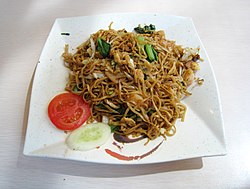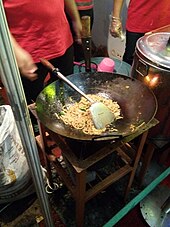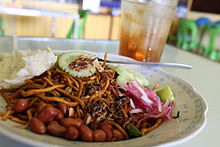Mie goreng
 Mie goreng in a restaurant in Jakarta | |
| Alternative names | Bakmi goreng, bami goreng, mi goreng |
|---|---|
| Type | Noodle |
| Course | Main course |
| Place of origin | Indonesia[1] |
| Region or state | Nationwide |
| Serving temperature | Hot |
| Main ingredients | Fried noodles with chicken, meat or prawn |
Mie goreng (Indonesian: mie goreng or mi goreng; meaning "fried noodles"[2]), also known as bakmi goreng,[3] is an Indonesian style of stir fried noodle dish. It is made with thin yellow noodles stir fried in cooking oil with garlic, onion or shallots, fried prawn, chicken, beef, or sliced bakso (meatballs), chili, Chinese cabbage, cabbages, tomatoes, egg, and other vegetables. Ubiquitous in Indonesia, it is sold by food vendors from street-hawkers, warungs, to high-end restaurants.
History[]

In Indonesia, where mie goreng is one of the most widespread simple dishes, the dish's origin is clearly associated with Chinese Indonesian cuisine.[1] Chinese influences are evident in Indonesian food, such as bakmi, mie ayam, pangsit, bakso, lumpia, kwetiau goreng, and mie goreng.[4] The dish is derived from Chinese chow mein and believed to have been introduced by Chinese immigrants in Indonesia. Despite being influenced by Chinese cuisine, mie goreng in Indonesia have a definite Indonesian taste, it has been more heavily integrated into Indonesian cuisine;[5] for example the application of popular sweet soy sauce that add mild sweetness,[6] sprinkle of fried shallots, addition of spicy sambal and the absence of pork and lard in favour of shrimp, chicken, or beef; to cater for the Muslim majority.
Preparation[]
Mie goreng are traditionally made with yellow wheat noodles, stir fried with chopped shallots, onion, and garlic with soy sauce seasoning, egg, vegetables, chicken, meat or seafood. However, other versions might use dried instant noodle instead of fresh yellow wheat noodle. A common practice in Indonesia is the inclusion of the powdered instant noodle seasonings, along with egg and vegetables. Authentic mie goreng uses fresh ingredients and spices, however, bottled instant spice paste might be used for practical reasons.[7]
The almost identical recipe is often used to create other dishes. For example bihun goreng is made by replacing yellow wheat noodle with bihun or rice vermicelli, while kwetiau goreng uses shahe fen or thick flat rice noodles instead.
Variations[]

A number of mie goreng variants exist. In Indonesia mie goreng variants are usually named after the ingredients, while some might be named after the region of origin.
- Mie goreng ayam or common mie goreng uses chicken with shallots, garlic, leek, sweet soy sauce, egg, and vegetables typically added as well.
- Mie goreng ayam penyet mie goreng topped with ayam penyet smashed fried chicken with sambal.
- Mie goreng sapi, similar to common traditional mie goreng, but uses beef instead.
- Mie goreng kambing uses goat meat or mutton.
- Mie goreng udang uses shrimp.
- Mie goreng seafood uses seafood which includes mixture of fish, squid, and shrimp.
- Mie Goreng Aceh a mie goreng variant from Aceh province, which uses a thicker noodle similar to that of spaghetti, and employs a curry-like rich spicy paste.[8]
- Mie goreng Jawa from Central Java, employ sweet soy sauce, egg, chicken, and vegetables. In restaurant, warung or travelling food vendor, it usually sold and offered together with mie rebus (lit. "boiled noodle") or mie Jawa.[9]
- Mie goreng tek-tek refer to mie goreng sold by travelling street hawkers that hitting the wok making "tek-tek" sounds to announce their wares. It is common in Jakarta and some large cities in Java, where street food hawkers commonly sell it together with nasi goreng (fried rice) and mie rebus from their food carts.
- Mie goreng dhog-dhog also known as Mie goreng Surabaya from Surabaya city. Refer to travelling food cart vendor selling mie goreng Surabaya that uses large wooden slit drum instead to announce his presence in the neighbourhood, thus creates "dhog-dhog" sounds.[10]

- Indomie Mi goreng the instant version of mie goreng, Indomie Mi goreng is also popular in Indonesia and other countries, notably Netherlands, Nigeria, Australia, New Zealand, United States and several Middle Eastern countries.[11] This instant version however, is not technically goreng (stir-fried), but boiled instead and seasoned after discarding the water used for boiling. Nevertheless, it tries to closely resemble the authentic mie goreng by adding sweet soy sauce and crispy fried shallot. It is commonly found in warung Indomie stalls that sell instant noodles, grilled sandwiches and hot drinks in Indonesian urban areas.
Indonesians tend to name similar foreign dishes as mie goreng, for example in Indonesia, chow mein is often called mie goreng Tionghoa and yakisoba is called mie goreng Jepang.
Gallery[]
Basic mie goreng tek-tek sold by travelling street vendor
Mie goreng with chicken and shrimp in Jakarta

Mie goreng udang with shrimp

Mie goreng Jawa, Javanese style seasoned with kecap

Mie goreng Aceh

Mie goreng Bali
Mie goreng served as part of hotel breakfast buffet
Mie goreng and nasi goreng combo, a hotel breakfast buffet
See also[]
- Mie kuah
- Mie ayam
- Indonesian cuisine
- Bakmi
- Bamischijf
References[]
- ^ Jump up to: a b Forshee, Jill (2006). Culture and Customs of Indonesia. Greenwood Publishing Group. ISBN 978-0-313-33339-2.
- ^ Guerin, Bill (23 December 2003). "World's top noodle maker loses its bite". Asia Times Online. Archived from the original on 15 February 2004. Retrieved 22 August 2007.CS1 maint: unfit URL (link)
- ^ Sara Schonhardt (25 February 2016). "40 Indonesian foods we can't live without". CNN.
- ^ Heinz Von Holzen (2014). A New Approach to Indonesian Cooking. Marshall Cavendish International Asia Pte Ltd. p. 15. ISBN 9789814634953.
- ^ "Indonesian Food: 50 of the Best Dishes You Should Eat". Migrationology. 2016-05-22. Retrieved 2020-02-16.
- ^ Janelle Bloom (August 2001). "Mie goreng". Taste.com.au Australian Good Taste.
- ^ "Indonesian Fried Noodles (Mie Goreng)". Rasa Malaysia. 9 August 2010.
- ^ "Mie Aceh Recipe". Indonesian Recipes.
- ^ "Mie Goreng Jawa". Tasty Indonesian Food.
- ^ Rinny Ermiyanti Yasin (1 February 2012). "Diferensiasi: Antara Tek-tek dengan Dhog-dhog" (in Indonesian). Kompasiana. Archived from the original on 11 July 2012. Retrieved 3 June 2012.
- ^ "Indomie Goreng". Indomie (in Indonesian). Archived from the original on 2017-04-29. Retrieved 2017-03-24.
| Wikimedia Commons has media related to Mie goreng. |
- Indonesian cuisine
- Acehnese cuisine
- Indonesian Chinese cuisine
- Javanese cuisine
- Street food in Indonesia
- Indonesian noodle dishes







